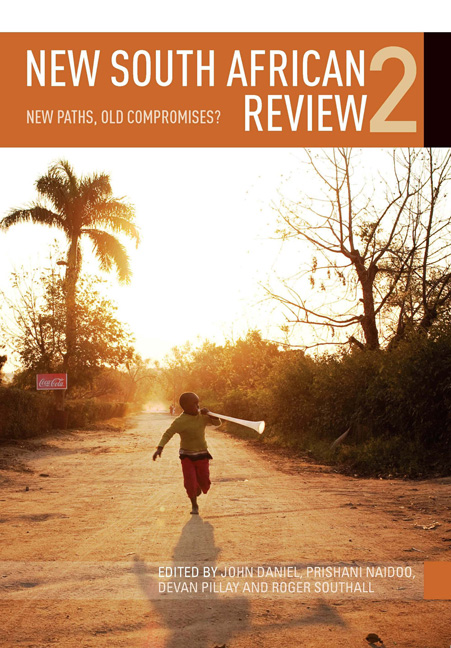Book contents
- Frontmatter
- Contents
- Preface
- Introduction: New paths, old (com)promises?
- PART 1 POLITICS AND INTERNATIONAL
- PART 2 ECONOMY AND SOCIETY
- PART 3 ENVIRONMENT
- Introduction: Ecological threats and the crisis of civilisation
- Chapter 14 Above and beyond South Africa's minerals-energy complex
- Chapter 15 Corrosion and externalities: The socio-economic impacts of acid mine drainage on the Witwatersrand
- Chapter 16 Food versus fuel? State, business, civil society and the bio-fuels debate in South Africa, 2003 to 2010
- PART 4 MEDIA
- Contributors
- Index
Chapter 15 - Corrosion and externalities: The socio-economic impacts of acid mine drainage on the Witwatersrand
from PART 3 - ENVIRONMENT
Published online by Cambridge University Press: 23 March 2018
- Frontmatter
- Contents
- Preface
- Introduction: New paths, old (com)promises?
- PART 1 POLITICS AND INTERNATIONAL
- PART 2 ECONOMY AND SOCIETY
- PART 3 ENVIRONMENT
- Introduction: Ecological threats and the crisis of civilisation
- Chapter 14 Above and beyond South Africa's minerals-energy complex
- Chapter 15 Corrosion and externalities: The socio-economic impacts of acid mine drainage on the Witwatersrand
- Chapter 16 Food versus fuel? State, business, civil society and the bio-fuels debate in South Africa, 2003 to 2010
- PART 4 MEDIA
- Contributors
- Index
Summary
‘Problems related to mining waste may be rated as second only to global warming and stratospheric ozone depletion in terms of ecological risk. The release to the environment of mining waste can result in profound, generally irreversible destruction of ecosystems.’
United States Environmental Protection Agency, 1987.‘Amongst the many things I learnt, as a president of our country, was the centrality of water in the social, political and economic affairs of the country, continent and indeed the world. I am, therefore, a totally committed “water person”.’
Nelson Mandela, 2002.INTRODUCTION
For over 125 years, the area around Johannesburg has been at the centre of the mining of the richest underground gold and uranium bearing reefs in southern Africa. Mining has occurred over an arc of approximately seventy-five kilometres, along a geological ridge of ‘white waters’, the Witwatersrand, or ‘Rand’, which also constitutes the continental divide: to the north of the ridge surface water flows into the Limpopo catchment and out into the Indian Ocean; to the south, surface water flows into the Vaal and subsequently via the Orange/Gariep River into the Atlantic (Turton et al., 2006: 316).
By the turn of the second decade of the twenty-first century, the gold is mostly no longer viable to be mined and, with a few exceptions, the mines have closed down. Although many of the companies which exploited the resource have disappeared, they have left an expensive legacy of environmental pollution, without having internalised these costs in their balance sheets or having been required by the state to pay them. Until recently, the state imposed little obligation on the mining companies, or their shareholders, to account for cleaning up the damage.
Because of the deep level of the gold-bearing ore, the Witwatersrand goldfields could only be exploited by means of huge capital investments, mostly from abroad, in the late nineteenth century. The mining industry demanded that African peasants be alienated from their land and taxed in order for them to seek paid work on the mines. This was the start of the migrant labour system which drew on the whole region of southern Africa for its manual workforce.
- Type
- Chapter
- Information
- New South African Review 2New paths, old compromises?, pp. 300 - 320Publisher: Wits University PressPrint publication year: 2012

